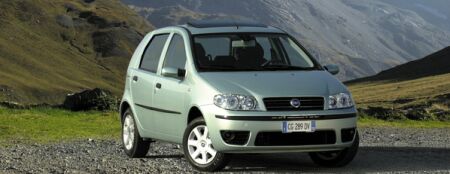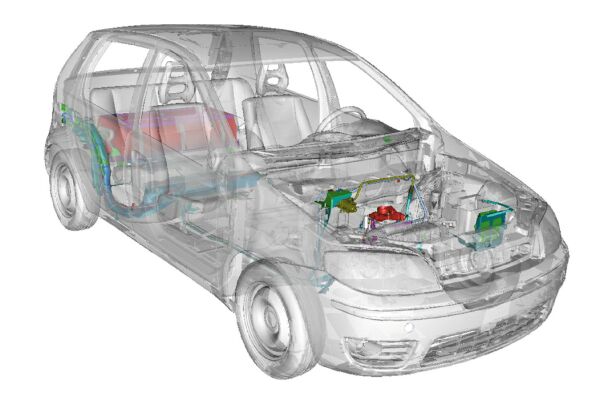
new models: Fiat Punto ( 2003 Restyling )
 |
| NATURAL POWER: THE GREEN
VERSION
The New Fiat Punto is the first car in segment B to offer a dual methane and petrol fuel system. The version is equipped with two independent fuel systems. The car normally runs on methane and only needs petrol for start up. After that, it automatically switches to the other system. In this way, the petrol fuel system remains efficient and is only required when the gas in the cylinders is about to run out. It is, however, always possible to change from methane to petrol and vice versa voluntarily by pressing a button on the facia. The power unit fitted to this particular version is a 1.2 8v fitted with a phased sequential Multipoint system. This engineering feature allows the engine to obtain all the benefits of a petrol engine from a methane engine. The New Fiat Punto Natural Power handles like a dream: when running on methane, maximum power output is 38 kW (52 bhp) at 5000 rpm, while the torque is 88 Nm at 3000 rpm. The values are 44 kW (60 bhp) and 102 Nm (10.4 kgm) when running on petrol. The New Punto Natural Power also offers good fuel economy and, above all, minimum emissions in absolute safety. This last aspect means the customer can drive around town centres with traffic restrictions (due to excessive pollution) and also park the car in garages. Moving on to the fuel consumption: when running on methane, the model consumes 5.5 kg/100 km (over an urban cycle), 3.7 kg/100 km (extra-urban) and 4.3 kg/100 km (combined); when running on petrol (the tank contains 47 litres), the results are 8.4 l/100 km, 5.6 l/100 km and 6.6 l/100 km. Lastly, the two methane cylinders in the luggage compartment have an overall capacity of 65 litres. These can hold 11 kg methane and assure a range of 260 kilometres (combined cycle). The performance figures are also very respectable. The green version of the New Fiat Punto can reach 151 km/h of top speed when running on petrol (145 km/h with methane) and accelerates from 0 to 100 km/h in 19 seconds (methane) and 17 seconds (petrol). The Punto Natural Power comes in a 5-door version and a 3-door van version and offers a long list of standard equipment: including two front airbags, Dualdrive electric power steering and ABS. This car is an excellent demonstration of Fiat Auto's commitment to the environment: methane engines are one of its main concerns. This is evidenced by the fact that Fiat has developed a full range of products to meet the needs of businesses and private individuals. The current model range includes a Multipla bipower (a very successful product on the market), a Ducato bipower, in various professional goods transport versions - and the recently launched Doblò bipower, in car and Cargo versions. Now these have been joined by the New Punto Natural Power. This diverse range covers the needs of an extensive category of users, particularly business, trade, good transport and small and medium-sized industries. Despite the fact that methane filling stations are few and far between in Italy, growing numbers of towns are joining the Methane Project - which has already exceeded membership expectations - and more and more business users are showing interest. In December 2001, Fiat also signed a major agreement over the development of methane engines for goods haulage in Italy with the Ministry for the Environment and the Petroleum Association. To improve air quality, methane is the only real short and medium-term alternative to renewing the current pool of cars on the road and it is also financially feasible. Methane is also the most environmentally-friendly natural fuel and its properties make it well-suited for use in internal combustion engines. And more. Italy has a long tradition of using this method that is incidentally also the best solution to the environmental problem that is such a concern to major cities: fine particulate. For all these reasons, the promotion of methane-driven goods haulage is a new strategic approach for Fiat Auto that is shared and supported by the Ministry for the Environment. Three fundamental aspects were highlighted when outlining the Programme Agreement. The first concerns the targeting of major Italian cities that experience the worst traffic pollution and the densest concentration of vehicles on the road. The second aspect concerns the targeting of business users who operate mainly in town, i.e. users who cover a lot of mileage and tend to use old vehicles that produce high pollution levels. The third aspect concerns the methane distribution network: this must be extended before demand can grow and methane-driven vehicles be accepted by business users. The Agreement was drawn up on the basis of these three factors in conjunction with the Ministry for the Environment. In 2002, an agreement was drawn up between the major Italian cities. As a result of the scheme, the Ministry for the Environment has specifically granted financial aid to promote vehicle demand and encourage growth in infrastructure. The subsidies were the largest ever seen in Italy. Significant results have been achieved during the few months since the project was set under way. Thirty major Italian provincial capitals have joined the scheme and have introduced or are about to introduce plans to extend or develop the methane distribution network in their area. The distribution network currently includes 398 refuelling points throughout Italy (the number was 344 before the Programme Agreement). 131 of these are present in the major Italian cities that have joined the methane scheme. The aim is to reach 750 points in Italy by 2005 (330 in Methane Project cities). This significant growth will be possible only with the commitment of signatory city authorities, the Petroleum Association and companies that are willing to become directly involved in distributing methane for road haulage. The great challenge of using methane for road haulage in Italy can only be met if distribution systems are set up. This growth must take place in major Italian metropolitan areas such as Rome, Milan, Turin and Naples that are currently the least well-equipped in terms of methane supply points. Without a definite willingness, commitment and determination on the part of the city authorities to achieve the distribution network development targets it will not be possible to make business users change their ways significantly. If this happens, we will be wasting the unique opportunity that the Programme Agreement offers us to improve the environment in our cities. If cities are unable to show a true commitment to steer public transport - and business transport in particular - toward the cleaner vehicles made available by the Programme Agreement, the pool of vehicles will not reach the critical mass required to feed a concomitant growth in the methane distribution network. Only through co-operation between the public and private sectors will we be able to prepare the ground for a different type of mobility that demonstrates respect for the environment. Fiat Auto is committed to this challenge and encouraged by the growing commitment of local authorities. Fiat Auto's efforts are not directed merely at extending the methane vehicle market, it is also carrying out research to improve methane engine performance and storage systems in the future. On the engine front, we are examining the possibility of adopting a near-direct methane injection system, i.e. a system with the injectors positioned against the intake valves. This offers advantages in terms of performance (more air can be taken in) and fuel consumption. Application of a hydraulic valve control system with elimination of the throttle will allow the antiknock qualities of methane to be exploited more effectively to optimise the compression ratio. |
 |
|
|
|
| <<< |